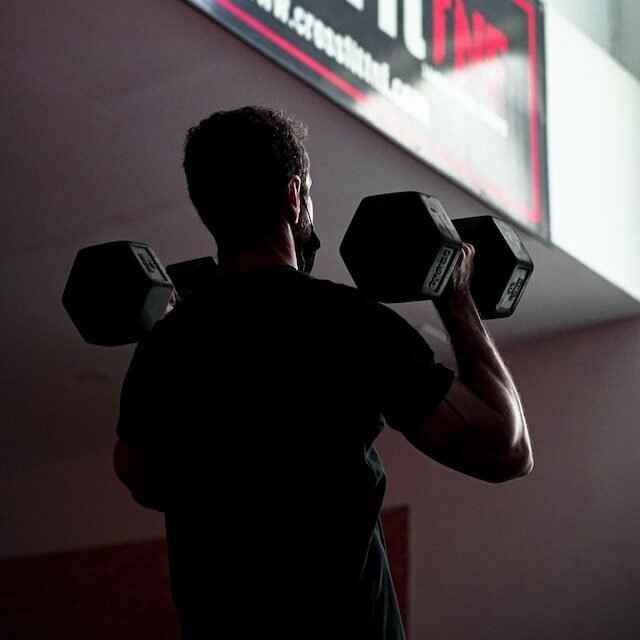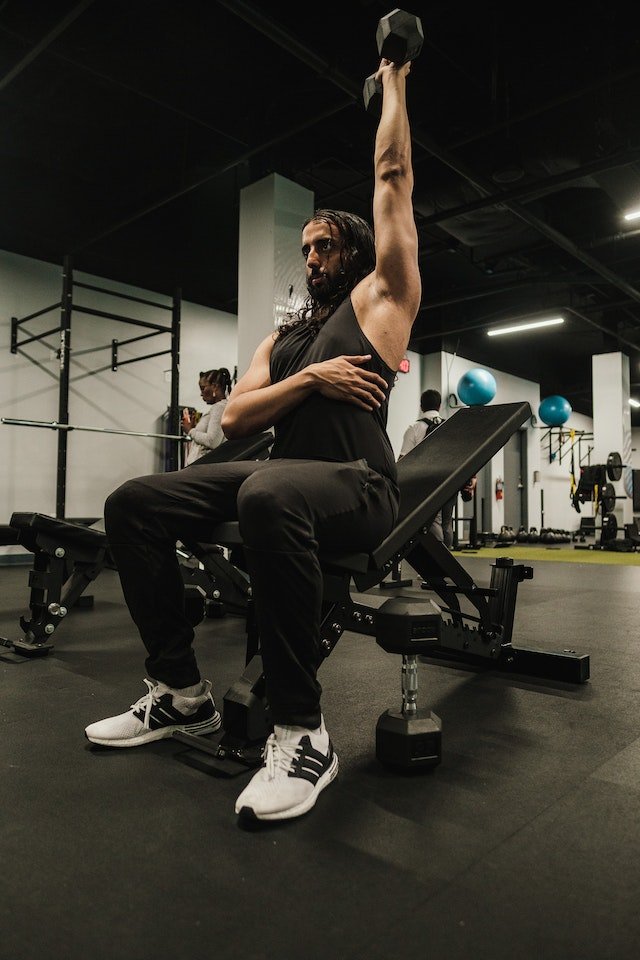Why Are My Shoulders Never Sore? 16 Crucial Factors To Consider
One of the questions I get asked frequently is “Why are my shoulders never sore?”
It can be frustrating at times because we associate soreness with progress.
There are a few different reasons this could be happening.
We all love working shoulders, whether it’s pressing, lateral raises, or shrugs. Sometimes though our shoulders just don’t seem to respond the way other muscle groups do.
Here are a few possible reasons why your shoulders might not be getting sore…
Why Are My Shoulders Never Sore?
There are a few possible explanations for why your shoulders might not be getting sore after working out. It could be that you’re not working out hard enough, or it could be that your muscles have adapted to the type of exercise you’re doing and no longer require as much recovery time. If you think you might be overtraining, it’s important to rest and give your body a chance to recover. Additionally, try changing up your workout routine to include new exercises and challenges for your muscles. This will help keep them active and engaged and can help prevent boredom and overuse injuries. Let’s not forget, that you don’t always have to feel sore every time you exercise, it’s a common fitness myth individuals lean towards. Lots of people never feel sore after working their shoulders, so don’t think you are the only one. Finally, make sure you’re stretching properly before and after your workouts. Stretching helps improve range of motion and can help prevent injuries. If you’re not sure how to stretch properly, consult with a certified personal trainer or physical therapist.
You don’t have to always be sore
You don’t always have to be sore to make progress and see results.
If you’re not feeling sore after shoulder workouts, it doesn’t necessarily mean you’re not working hard enough or that something is wrong.
There are many factors that contribute to why someone might not feel sore after a workout.
Always trying to seek out muscle soreness when working your shoulders can be potentially dangerous and lead to injury.
You need to change your perspective and focus on other aspects of your workout routine, such as intensity, volume, and exercise selection.
Try changing up your routine, resting when needed, and stretching properly before and after exercise.
These tips can help you prevent overtraining and injuries, while also helping to improve your range of motion.
If you’re still not sure why you’re not feeling sore, talk to a certified personal trainer or physical therapist for guidance.
Lots of people don’t get DOMS after working shoulders
DOMS, or delayed onset muscle soreness, is the pain and stiffness you feel 24-48 hours after a workout.
Not everyone experiences DOMS after exercise, and there’s no need to worry if you don’t.
There are many factors that can contribute to why someone doesn’t experience DOMS, such as:
- genetics
- type of exercise
- intensity of exercise
- duration of exercise
- frequency of exercise
- previous experience with the exercise
As the deltoid muscles are a smaller group, it’s less likely that you’ll experience DOMS after working them, as compared to other larger muscle groups.
Many people DONT experience DOMS, and that’s okay!

Shoulders are utilised with lots of other exercises
The other thing you have to consider is that the shoulders are utilised in a lot of different exercises, not just shoulder-specific movements.
For example, when you’re doing chest presses, your shoulders are engaged to stabilise the weight.
The same goes for other upper body exercises like rows and pull-ups.
This means that your shoulders are getting a lot of work even when you’re not specifically targeting them.
As a result, they may not require as much recovery time and may not feel as sore after workouts.
This is perfectly normal and nothing to worry about.
Once again, don’t be too hard on yourself if you’re not feeling sore after shoulder workouts.
One thing you could try to see if it makes a difference when working your shoulders is to increase the time under tension.
Related: Why Am I Weaker Than My Last Workout? All You Need To Know To Get Back On Track Fast
Time under tension
This means performing exercises with a slow and controlled tempo, making sure your muscles are under tension for a longer period of time.
This can stimulate muscle growth and help you see results.
Another thing you could try is increasing the volume of your shoulder workouts.
This means doing more sets and reps or adding more weight to your exercises.
However, you must be extremely careful when exercising your shoulders, due to the fact they are a very important joint in the body.
If you overdo it, you could end up causing serious injury.
Many people who have been exercising for some time push too hard when working their shoulders (myself included here) which inevitably ends in injury.
This becomes problematic due to the fact the shoulder joint is a very mobile joint, which means it’s more susceptible to injury.
So if you’re going to increase the volume or intensity of your shoulder workouts, make sure you do so gradually and with proper form.
Additionally, focus on other muscle groups from time to time and give your shoulders a break.
This will help prevent overuse injuries and allow your shoulders to recover.
Change the way you do exercises
If you’re still not seeing results or feeling sore after shoulder workouts, it may be time to change the way you’re doing exercises.
There are many different ways to target the same muscle group, so don’t be afraid to experiment.
Change the angle, grip, or stance of your exercises.
Use dumbbells, barbells, or resistance bands.
Try different exercises altogether.
There are endless possibilities, so get creative and find what works best for you.
There are various ways of lifting weights, and they can help keep your body guessing when it comes to training, check out the list below…
Blood Flow Restriction Training – This is where you restrict the flow of blood to the working muscles. It’s often used to help people recover from injuries but it can also be quite painful.
Isometrics – You hold a muscle in a static position for some time. It’s a great way to build strength.
Crossfit – This is training that incorporates a lot of different exercises, often at high intensity. It’s great for improving fitness but it can also be quite tough on the body.
High-Intensity Interval Training – This type of training alternates between periods of high and low intensity. It’s great for improving fitness.
Tabata – This is a type of high-intensity interval training that is very intense. Tabata training breaks a workout down into clearly defined intervals – typically, 20 seconds of a push-it-to-the-limit exercise followed by 10 seconds of rest.
Drop Sets – A type of weightlifting where you lower the weight after each set. It’s a great way to build strength and muscle.
Super Sets – Weightlifting where you do two or more sets of an exercise back-to-back with no rest in between. It’s a great way to build strength and muscle.
Rest-Pause Sets – This is a type of weightlifting where you take a short break after each rep. It’s a great way to build strength and muscle but it can also be quite tough on the body.
Forced Reps – Weightlifting where you have someone else help you with the last few reps of an exercise. It’s a great way to build strength and muscle.
Negative Reps – A type of weightlifting where you lower the weight slower than you lift it. It’s a great way to build strength and muscle.
Pyramid Sets – This is a type of weightlifting where you start with a lighter weight and then gradually increase the weight as you go. It’s a great way to build strength and muscle.
As you can see, there are a variety of ways to lift weights, which will all help keep your body guessing and help make gains.

Increase volume and intensity gradually
When increasing the volume of your workouts, it’s important to do so gradually.
Your muscles need time to adapt to the new challenges you’re putting them through.
If you increase the volume too quickly, you risk overtraining and getting injured.
Start by adding a few extra reps or sets to your workouts.
Then, once your muscles have adjusted, you can start adding more weight or reps.
If you’re still not seeing results, it may be time to increase the intensity of your workouts.
You can do this by lifting heavier weights, doing more reps, or increasing the amount of time you spend working out.
Remember to increase the intensity gradually so you don’t overtrain your muscles.
Related: Is Progressive Overload Important On A Calorie Deficit? (4 Things To Achieve Maximum Overload)
Get enough sleep
Sleep is important for recovery and growth.
During sleep, your body repairs damaged cells and produces new ones.
This is especially important for muscles, which grow and get stronger during sleep.
To see results from your weightlifting, you need to make sure you’re getting enough sleep.
Most people need around eight hours of sleep per night but you might not need as much or you may need more, see what works best for you.
If you’re not getting enough sleep, your body won’t have time to recover and you won’t see the results you’re hoping for.
If you want to see results from your weightlifting, make sure you’re working out hard enough, resting enough, and getting enough sleep.
These are all important factors in muscle growth and recovery. If you’re still not feeling sore you might be one of those people that doesn’t feel it on their shoulders.
Use a training journal
A training journal can be a great way to track your progress and see results from your training sessions.
In your journal, you can track the exercises you’re doing, the weights you’re lifting, and the sets and reps you’re doing.
You can also track how you’re feeling after each workout and make note of any changes you see in your body.
A training journal is a great way to see results from your weightlifting and to make sure you’re on track to reach your goals.
It’s best to Judge progress on the weight you have lifted, how they feel, how they look, and the way your shoulders operate daily.
Remember, feeling sore after working out isnt the only way to tell if you did a good job. Use a training journal to help you see results from your workouts.
Change up routine
If you feel like you’re not seeing results, it may be time to change up your routine.
Your muscles can adapt to the exercises you’re doing, which can make it harder to see results.
To keep your muscles guessing, and to see the best results, it’s important to change up your routine regularly.
Try adding new exercises, changing the order of your exercises, or increasing the weight you’re lifting.
You can also try different types of workouts, like circuit training or HIIT.
Changing up your routine will help you see results from your weightlifting and can also help prevent boredom and overuse injuries.
Mind muscle connection
The mind-muscle connection is the link between your mind and your muscles.
When you’re lifting weights, it’s important to focus on the muscles you’re working.
This will help them work harder and can help you see results from your weightlifting.
To connect your mind and muscles, focus on the muscle you’re trying to work.
Feel the muscle contracting as you lift the weight.
Visualize the muscle getting bigger and stronger with each rep.
The mind-muscle connection is important for seeing results from your weightlifting.
Are you going to failure?
One of the most important things you can do to see results is to go to failure.
Lifting to failure means you’re unable to do another rep with good form.
When you lift to failure, you’re pushing your muscles to their limits, which is what helps them grow.
If you’re not lifting to failure, you’re not giving your muscles the stimulus they need to grow.
To see results from your weightlifting, make sure you’re pushing yourself to failure on every set.
On the flip side, some people would advise to not go to failure, especially with your shoulders. The best thing to do is give it a try and see what works best for you.

Healthy eating
You can’t out-exercise a bad diet.
If you want to see results you need to eat healthily.
Eating healthy means getting enough protein, eating plenty of fruits and vegetables, and avoiding processed foods.
Protein is especially important for weightlifters because it helps build and repair muscles.
Make sure you’re getting enough protein by including lean meats, eggs, dairy, and protein powder in your diet.
You should also be eating plenty of fruits and vegetables, which are important for overall health and can help you recover from your workouts.
Avoid processed foods, which are high in calories and low in nutrients.
Progressive overload?
Progressive overload is the process of slowly increasing the amount of weight you’re lifting over time.
Have you tried this with regard to working your shoulders?
As your muscles adapt to the weight you’re lifting, you need to gradually increase the amount of weight to keep them challenged.
If you don’t progressively overload your muscles, they will stop growing.
To see results make sure you’re gradually increasing the amount of weight you’re lifting over time, as well as keeping track of your progress.
Related: What Is The Most Painful Gym Exercise? (All The Answers Here)
Mental block
Having a mental block is when you’re unable to do an exercise because of psychological reasons.
Mental blocks are common in weightlifting, and they can prevent you from seeing results.
To overcome a mental block, it’s important to focus on your form and technique.
Visualize yourself doing the exercise perfectly.
Focus on your breathing and contracting the muscle you’re working.
And don’t be afraid to ask for help from a trainer or fellow weightlifter.
If you’re struggling with a mental block, remember to focus on your form, technique, and breathing.
Have patience
Lifting weights is a long-term process, and results take time. Don’t be discouraged if you don’t see results immediately.
Keep working hard, and eventually, you will see the results you’re looking for. Weightlifting is a long-term process, and results take time.
The key to seeing results from your weightlifting is consistency. If you’re not consistent with your workouts, you won’t see results.
Make sure you’re working out regularly and sticking to your routine, and don’t be afraid to mix things up from time to time to keep your muscles challenged.
Range of motion issues?
Range of motion is the distance your muscles can move through their full range of motion.
If you have a poor range of motion, it means your muscles aren’t able to contract fully, which can limit your results.
To improve your range of motion, make sure you’re stretching properly before and after your workouts.
Additionally, try adding some mobility exercises to your routine. These exercises help improve your range of motion and can prevent injuries.
If you think your range of motion might be an issue, focus on stretching and adding mobility exercises to your routine.
Final Thoughts…
If your shoulders aren’t feeling sore after working out, it’s not necessarily a bad thing.
Try changing up your workout routine to include new exercises and challenges for your muscles. This will help keep them active and engaged and can help prevent boredom and overuse injuries.
Make sure you’re stretching properly before and after your workouts. Stretching helps improve your range of motion and can prevent injuries.
If you’re not seeing results from your workouts, there could be several reasons why.
Make sure you progressively overload your muscles, focus on your form and technique, and be patient.
Have your experienced this issue when working your shoulders, how did you get back on track? Let me know in the comments section below.


